SELF DRILLING SCREWS
Self-drilling screw is a kind of fastener which combines the functions of drilling and thread cutting, and is widely used in many fields such as architecture, furniture manufacturing, metal processing and so on. The following are the main advantages of self-drilling screws.
Convenient installation, time-saving and labor-saving: traditional screws need to be drilled before installation, while self-drilling screws can directly drill holes and tap on the surface of materials, greatly simplifying the construction steps. The use of extra tools is reduced, and the installation efficiency is improved.
No pre-drilling: Self-drilling screw has its own drill bit structure, which can be directly used on different materials such as metal, wood and plastic. The design without pre-drilling not only saves the construction time, but also reduces the trouble of tool switching.
Suitable for various materials: self-drilling screws are suitable for various materials, such as thin metal plates, wood, PVC plates and so on. Workpieces with different materials and thicknesses can be firmly connected by selecting appropriate screws.
Cost saving: Since tools and manual operation steps are reduced, self-drilling screws can effectively reduce the engineering cost. In addition, its high efficiency also reduces the waste of materials and processing errors that may occur in construction.
Strong corrosion resistance: many self-drilling screws have been specially treated, such as zinc plating or coating protection, which can effectively resist the corrosion of moisture, chemicals and other factors and prolong their service life.
-

A self-drilling screw has a drill bit point that eliminates separate drilling and tapping operations for faster, more economical installations. The drill point allows these drill screws to be installed into steel base materials up to 1/2" thick. Self-drilling screws are available in a variety of head styles, thread lengths, and drill flute lengths for screw diameters #6 thru 5/16"-18.
-

Truss Head Self Drilling Screw are commonly used to attach cabinets to steel studs. They are also used in applications requiring low clearance above the head. Finally, Truss Head Tek Screw are used to assemble metal parts that will be used in humid environments.
-

What's a pan head screw? One versatile type of screw used primarily for metal-to-metal applications are pan head screws. This utilitarian screw features a broad head with rounded edges that some compare to an upside down frying pan and requires a tapped hole. A self-drilling screw has a drill bit point that eliminates separate drilling and tapping operations for faster, more economical installations. The drill point allows these drill screws to be installed into steel base materials up to 1/2" thick. Self-drilling screws are available in a variety of head styles, thread lengths, and drill flute lengths for screw diameters #6 thru 5/16"-18.
-

Csk Phillips head self-drilling Screws are high strength and durable fasteners used for sheet metal applications. To provide a perfect assembly, the countersunk variation of the philip screw has to be used in conjunction with a countersunk hole. The usage of these screws requires a pre-drilled hole. The screws themselves are threaded with twisted gradation which makes it easy to install on the pilot hole. This allows the screws to be used in high-precision applications like machine and electrical component assembly
-
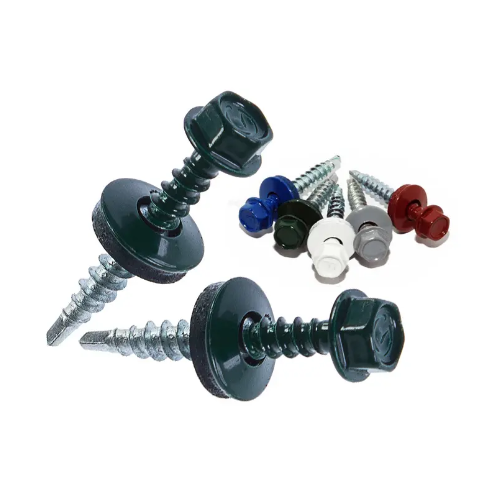
Enamelled Hex Head Self Drilling Screw Color Painted Hex Head Self Drilling Screw is strong corrosion resistant on outside roofing sheets working.
-
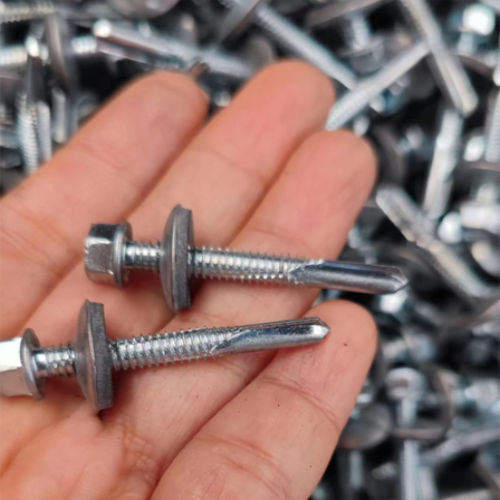
Drilling Point #5 Self Drilling Screw for 15mm thick metal sheets
-
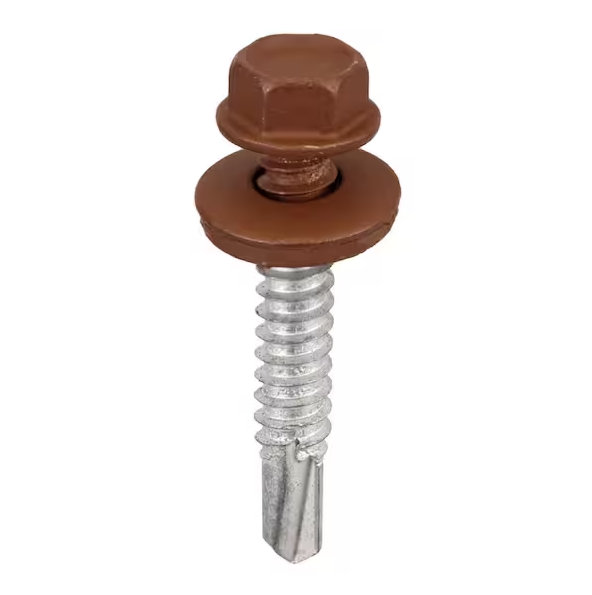
Enamelled Hex Head Self Drilling Screw Color Painted Hex Head Self Drilling Screw
-
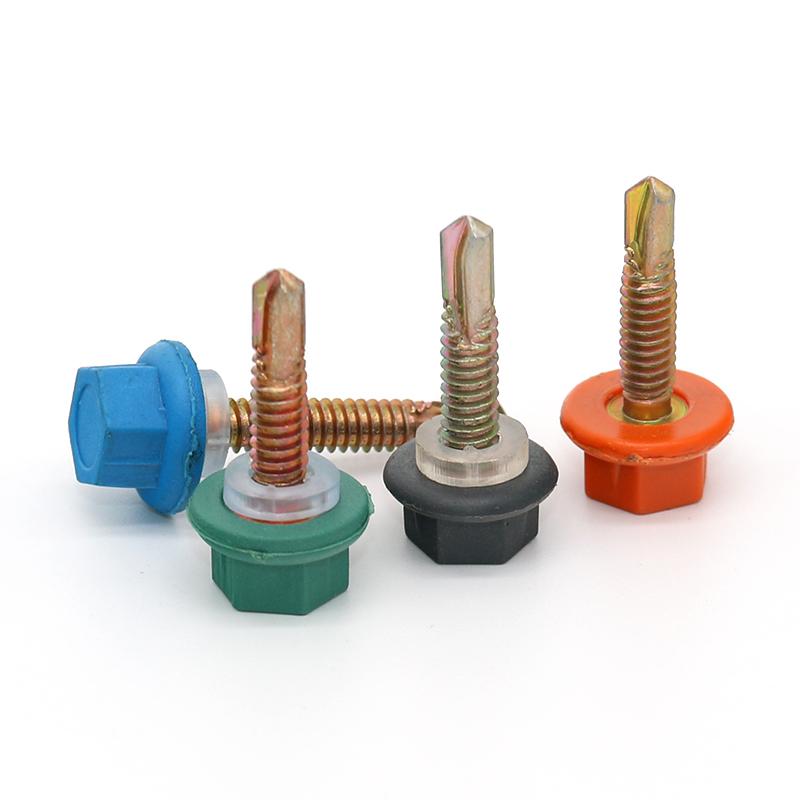
Colorful Plastic Cap Nylon Hex Flange Head Self Drilling Screw Roofing Screw Sheet Metal Screw Standard DIN 7504K Inside Diameter ST3.5-ST6.3 Material C1022A
-
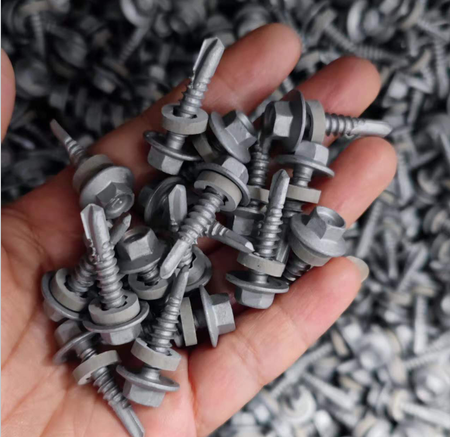
Ruspert coated self drilling screws work in high corrosion environment. It can be compliant with ASTM B117, ASTM B695, DIN50018, DIN50021 and AS3566.2.Ruspert color covers Silver, Grey, Blue, Brown, White, etc.500 hours, 1000 hours and 1500 hours hours can be selected for Salt Spray Test.5 cycles, 15 cycles and 20 cycles are available for Kesternich Test.
Strength of Self-Drilling Screws
Axial tensile strength: the axial tensile strength of self-drilling screws depends on many factors, including its material, thread design and anchorage after drilling into the material. Generally speaking, self-drilling screws are made of carbon steel, stainless steel and other materials. For example, high-quality carbon steel self-drilling screws can withstand a certain degree of axial tension after drilling into metal plates. In the field of architecture, when used to fix the color steel plate on the roof, the self-drilling screws with normal specifications can withstand large wind suction. If it is screwed into a metal plate with appropriate thickness according to the correct installation process (such as 0.61.0mm thick color steel plate), it can resist the wind suction of at least 1.01.5kN per square meter and ensure that the color steel plate will not be lifted under normal wind conditions.
Shear strength: the shear strength of self-drilling screws is also very important to ensure the stability of the connection structure. Its shear strength is related to the diameter and material of the screw and the friction between the thread and the connected material. In automobile manufacturing, self-drilling screws are used to fix some thin plate structures in non-critical parts, such as the fixing of automobile interior panels. When the vehicle is subjected to vibration, collision, etc. during driving, these self-drilling screws can bear a certain shear force at the joint. Taking a self-drilling screw with a diameter of 4mm as an example, the shear strength can reach about 35kN in the connection of suitable materials (such as fixing plastic interior panels and thin metal brackets), which effectively prevents the interior panels from shifting due to external force.
Durability of Self-Drilling Screws
Corrosion resistance: If the self-drilling screw is made of stainless steel, it has good corrosion resistance. For example, 304 stainless steel self-drilling screws can be used for many years without rusting in general outdoor environment (such as environment with high humidity and a little acid rain). This is because stainless steel contains alloying elements such as chromium, which can form a dense oxide film on the surface to prevent oxygen and moisture from further corroding the screw. In the building facilities in coastal areas, such as the awning on the seashore and the simple railing of the wharf, the use of stainless steel self-drilling screws can effectively resist the corrosion caused by seawater and sea breeze.
Wear resistance: the wear resistance of self-drilling screws is mainly reflected in its drill tip and thread part. Because the drill tip will rub with the material when drilling into it, it needs good wear resistance. The drill tips of many self-drilling screws are made of cemented carbide, which has high hardness and good wear resistance. In the industrial environment where self-drilling screws are frequently used, such as the prefabrication factory of steel structure, even if they are installed and used for many times, their drill tips can maintain a good sharpness and can effectively penetrate materials. At the same time, the wear resistance of the thread is also very important. Good thread wear resistance design can ensure that the thread will not be damaged by vibration, friction and other factors during long-term use, thus ensuring the fastening of the connection. For example, the thread self-drilling screw with special surface treatment (such as hard chromium plating) will obviously reduce the thread wear speed and prolong its service life by about 30% to 50% in the connection environment with certain friction (such as the connection between wood and metal).
Anti-loosening performance: after drilling into the material, the thread of the self-drilling screw is closely combined with the material, which has good anti-loosening performance. Especially in the environment with vibration, such as fixing the shell of mechanical equipment, installing the outdoor unit of air conditioner, etc. In these application scenarios, self-drilling screws can keep the connection relatively stable under long-term vibration environment through the friction between their own threads and materials and possible mechanical occlusion. Some self-drilling screws will also adopt special anti-loosening design, such as adding nylon washers or using coatings with thread locking agents to further improve their anti-loosening performance and make the connection structure durable and reliable under complex working conditions.



